 advertisements advertisements
|

|
Soyuz MS-09 returns station crew to Earth after 197 days in space
December 20, 2018 — A cosmonaut and two astronauts have safely landed from the International Space Station, returning to Earth on board a spacecraft that had been the source of a leak aboard the orbiting outpost.
Sergey Prokopyev of Roscosmos, Alexander Gerst with the European Space Agency (ESA) and Serena Auñón-Chancellor of NASA touched down Thursday (Dec. 20) aboard Russia's Soyuz MS-09 spacecraft. Their landing at 12:02 a.m EST (0502 GMT or 11:02 a.m. local time) southeast of the town of Dzhezkazgan, Kazakhstan, brought the three crew members home after 197 days in space.
The Soyuz descent module was met shortly after landing upright on the snowy Kazakh steppe by Russian, NASA and ESA teams, who helped Prokopyev, Gerst and Auñón-Chancellor exit the capsule and begin their readjustment to gravity.
Prokopyev, Gerst and Auñón-Chancellor began their return with the undocking of the Soyuz MS-09 spacecraft from the station's Rassvet module on Wednesday (Dec. 19) at 8:40 p.m. EST (0140 GMT Dec. 20). About three hours later, after a de-orbit burn put the spacecraft on a path to re-entry, the crew aboard the descent module separated from the Soyuz's service and orbital modules, leaving the spent sections to burn up in the atmosphere.
A small hole in the orbital module was determined to be the source of a pressure leak that briefly plagued the space station in late August. Following the advice of flight controllers on the ground, Prokopyev applied epoxy to a gauze wipe to plug the hole, which successfully stopped the leak.
On Dec. 11, eight days before undocking, Prokopyev joined cosmonaut Oleg Kononenko on a nearly 8-hour spacewalk to cut into the orbital module's insulation to find the corresponding hole in the hull's exterior. The spacewalkers collected samples of the extruded epoxy residue to return to Earth in an effort to determine the still unknown cause of the damage.
Kononenko with Roscosmos, NASA astronaut Anne McClain and David Saint-Jacques of the Canadian Space Agency, who arrived at the station on Dec. 3 and served as members of the Expedition 57 crew under Gerst's lead, remain aboard the orbiting laboratory. The departure of Soyuz MS-09 marked the completion of Expedition 57, the space station's 57th crew contingent since Expedition 1 took up residency in November 2000.
Gerst turned over command to Kononenko on Tuesday (Dec. 18), and continued a tradition by passing his successor a symbolic key to the space station, a tool used to open and close the hatch of the Soyuz.
"Expedition 57 is coming to a successful end," said Gerst during a brief change of command ceremony. "Despite some of the challenges that we had, in every one of these situations we were able to come together, the international partners, the crews, the control centers, and do what we are really good at as this international cooperation, to adapt to challenges, to changes and turn all situations to the best."
"We also were able to complete a great scientific program," added Gerst. "We had about 300 scientific experiments. We looked at new materials, investigated climate change, observed life cells, worked on cancer medication to improve treatments against cancer, improved treatments for Parkinson's and Alzheimer's disease, did plasma and quantum physics and last but not least tested new technologies that will enable us to go further to the moon and Mars."
The Expedition 56/57 crewmates also oversaw the arrivals and departures of eight uncrewed cargo vehicles, including two SpaceX Dragon capsules, two Northrop Grumman Cygnus freighters, a Japanese H-II Transfer Vehicle and three Russian Progress spacecraft. In addition to his spacewalk to investigate the hole in Soyuz MS-09, Prokopyev also conducted an extravehicular activity with cosmonaut Oleg Artemyev to deploy four small satellites and retrieve experiments mounted on the Russian segment of the space station.
This was Prokopyev's and Auñón-Chancellor's first mission and Gerst's second. With a total of 362 days in orbit, Gerst now holds the flight duration record among ESA astronauts.
The three Soyuz MS-09 crew members will now return to their respective space agencies after a brief flight by helicopter to a recovery staging area in southern Kazakhstan. From there, Prokopyev will depart for Star City, outside of Moscow, Auñón-Chancellor and Gerst will fly by NASA jet to a refueling stop in Norway, where Auñón-Chancellor will continue on to the Johnson Space Center in Houston and Gerst will be flown to the European Astronaut Centre in Cologne, Germany.
Three more Expedition 58 crew members, Aleksey Ovchinin of Roscosmos and NASA astronauts Nick Hague and Christina Koch, are scheduled to launch to the space station on Soyuz MS-12 on Feb. 28, 2019.
Soyuz MS-09 was the 55th Russian Soyuz spacecraft to fly to the International Space Station. It traveled a total of 83.3 million miles (134 million kilometers) over the course of 3,152 orbits of Earth. |
|
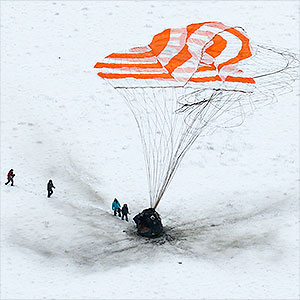
The Soyuz MS-09 spacecraft is seen after landing on the steppe of Kazakhstan after 195 days at the space station. (Roscosmos)
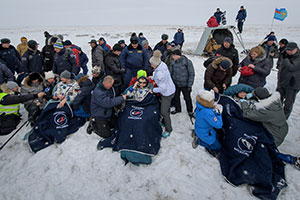
Alexander Gerst, Sergey Prokopyev and Serena Auñón-Chancellor are seen after landing aboard Soyuz MS-09. (NASA/Bill Ingalls)
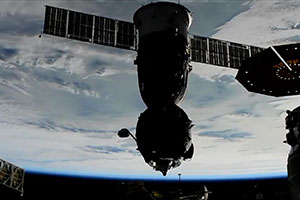
Soyuz MS-09 undocks from the Rassvet module at the International Space Station after 197 days in orbit. (NASA TV)
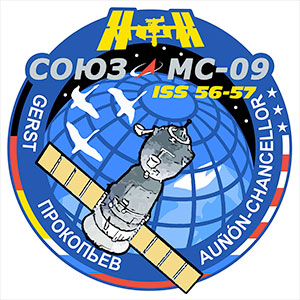
Soyuz MS-09 crew patch. (Roscosmos/Spacepatches.nl) |
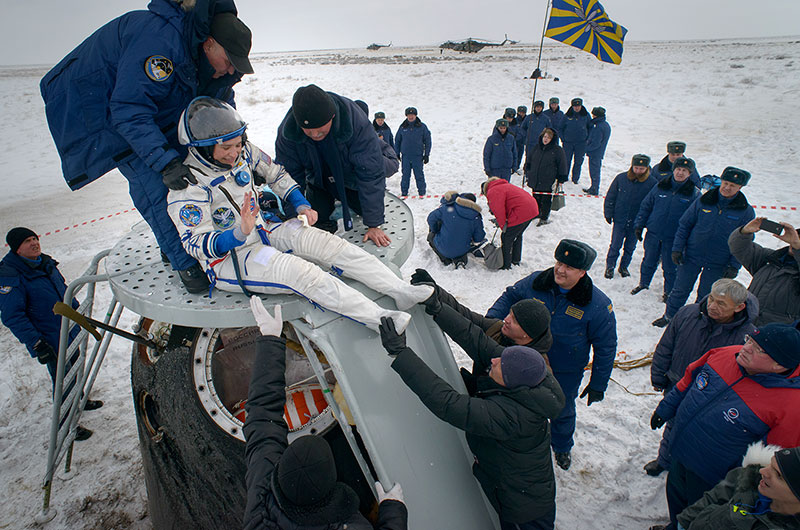
NASA astronaut Serena Auñón-Chancellor is helped out of the Soyuz MS-09 spacecraft just minutes after she, Sergey Prokopyev of Roscosmos and Alexander Gerst of the European Space Agency landed in a remote area of Kazakhstan on Thursday, Dec. 20, 2018. (NASA/Bill Ingalls) |
|

© collectSPACE. All rights reserved.
|
|

|

|
